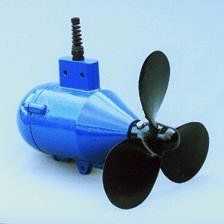First off....I know some, if not most, of you are anti-gadget on river trips. This thread isn't for you and I frankly just don't even want to hear anything from you. There are some trips that I like to go that way too, but I'm also a techy nerd and if not for any other reason than to see how it works I wan to try this but I'm just not interested in hearing from the anti-tech crowd on here....at all. I'm serious.
Ok, now that I have that out of the way....
So it has occurred to me that when on the river, we have a an abundant resource for power generation flowing by the whole time. I have a solar charger, but its slow and if its not bright enough it just doesn't work at all. Most camps have decent current and plenty of places to hook a tether.
I've seen a few designs on the net that are essentially a waterproof pod with an electrical generator inside and a propeller attached to the generator through waterproof coupler. It seems really simple, but they want like $1200-2500 for it or something crazy. Here is a picture and video of it in use...
![Image]()
https://www.youtube.com/watch?v=D0arh8aRhHY
I have the tools to make it (Mill and Lathe and welding equipment), but lack the electrical engineering expertise to know how to calculate things and to know how fast a generator needs to spin and such. I'm assuming the unit has some gearing to spin the generator faster, but I'm not sure.
The people who make the expensive one claim 100 watts of power at 12v, 24v, or 48v...which is honestly enough to run a laptop or other more power hungry devices if you wanted to (the one in the video is evidently powering a street light on a bridge nearby). I'm not saying that is what I want necessarily (though movie night halfway through the grand canyon might be pretty cool). Mostly what I would want it for would be enough to charge a GPS, Camera, or GoPro on occasion with a more reliable way then Solar. I'd change the design a bit to be something tethered to shore that you just drop in the water and let it run.
I know there are some engineer types on here, so let me know if you have any ideas about this. I'm sure there are patents on this kind of thing, so at this point I'm not really interested in making this as a product, but who knows what the future brings.
Ok, now that I have that out of the way....
So it has occurred to me that when on the river, we have a an abundant resource for power generation flowing by the whole time. I have a solar charger, but its slow and if its not bright enough it just doesn't work at all. Most camps have decent current and plenty of places to hook a tether.
I've seen a few designs on the net that are essentially a waterproof pod with an electrical generator inside and a propeller attached to the generator through waterproof coupler. It seems really simple, but they want like $1200-2500 for it or something crazy. Here is a picture and video of it in use...

https://www.youtube.com/watch?v=D0arh8aRhHY
I have the tools to make it (Mill and Lathe and welding equipment), but lack the electrical engineering expertise to know how to calculate things and to know how fast a generator needs to spin and such. I'm assuming the unit has some gearing to spin the generator faster, but I'm not sure.
The people who make the expensive one claim 100 watts of power at 12v, 24v, or 48v...which is honestly enough to run a laptop or other more power hungry devices if you wanted to (the one in the video is evidently powering a street light on a bridge nearby). I'm not saying that is what I want necessarily (though movie night halfway through the grand canyon might be pretty cool). Mostly what I would want it for would be enough to charge a GPS, Camera, or GoPro on occasion with a more reliable way then Solar. I'd change the design a bit to be something tethered to shore that you just drop in the water and let it run.
I know there are some engineer types on here, so let me know if you have any ideas about this. I'm sure there are patents on this kind of thing, so at this point I'm not really interested in making this as a product, but who knows what the future brings.







